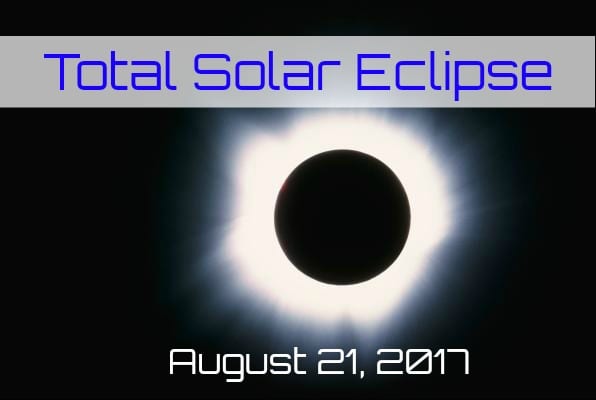Imagine the sky darkening, though the sky is clear. The temperature noticeably drops. The brightest stars and planets pop out in the subdued sky. All around, the horizon is ablaze in red and orange hues, while overhead the sky is a blue-black. The Sun, blocked by the Moon, now appears to be an impossibly black hole. Insects begin chirping, as they do at dusk. This is a total solar eclipse.
The Moon, lit by the Sun, casts a shadow into space. On the morning of August 21, 2017, that shadow will fall upon the mid-Pacific Ocean and race across the globe in a sweeping arc towards Salem, Oregon. It will then continue across the United States in a southeasterly arc, finally passing through Charleston, South Carolina and out into the Atlantic Ocean. As the Moon orbits about Earth so does its shadow trace a path at supersonic speed.
This will be the first total solar eclipse to be seen from the contiguous United States in 38 years and it is one of those rare events that you and your family will not want to miss. Thanks to John Aviste for making me aware of this unique event; the next North American total solar eclipse will not occur until 2024.
John Aviste is an engineer with a deep enthusiasm for space, and he also runs summer youth programs in upstate NY and Boston through his organization: Edge on Science. In John’s space-focused camp, Galileo’s Astronomy, students have the opportunity to explore astronomy and model both solar and lunar eclipses.
Plan Your Viewing
For the total solar eclipse on August 21, John says you want to plan on being near the centerline of the eclipse path. Detailed maps showing this path, along with accurate timings, are found here: Total Eclipse Path. Because the shadow passes so quickly, the Sun is totally blocked by the Moon for between 1m 59s and 2m 40s, depending on where along the path you are watching it from. As you can see, planning is in order. Here is a partial list of considerations:
- Locate an accessible, permissible and safe place from which to view the eclipse
- Pay attention to the weather forecast in the days leading up to the eclipse and have a plan, to relocate early, if practical
- The total phase of the eclipse is short, so be clear on why you’re traveling to see it
If you are outside the eclipse path, the Sun will only be partially eclipsed. All of North America will see at least a partial eclipse. The further from the path you are, the less of the Sun is blocked by the Moon.
To learn more, visit NASA’s eclipse page: 2017 Eclipse. And be sure to watch the animation called, Tracing the 2017 Solar Eclipse. It shows the shadow’s dramatic progression across the United States.
Now for a word of caution. Never directly view the Sun, even if the Sun is partially blocked by the Moon. If you do, the Sun’s rays will burn your retinas, causing permanent eye damage. Even if just a sliver of the Sun’s disk is visible, the risk of damage is the same. Only purchase eclipse glasses with ISO 12312-2 printed on them by the following companies: American Paper Optics, Rainbow Symphony, Thousand Oaks Optical and TSE 17 (source: NASA). Here are NASA’s complete safe viewing guidelines: Safe Viewing of the Total Eclipse of the Sun.
Photo Credit: NOAO/AURA/NSF- Total solar eclipse of March 7, 1970 showing the Sun’s corona
References:
Map of North American Total Solar Eclipses 1951 – 2000: Source- Fred Espenak / NASA
Map of North American Total Solar Eclipses 2001 – 2050: Source- Fred Espenak /NASA






